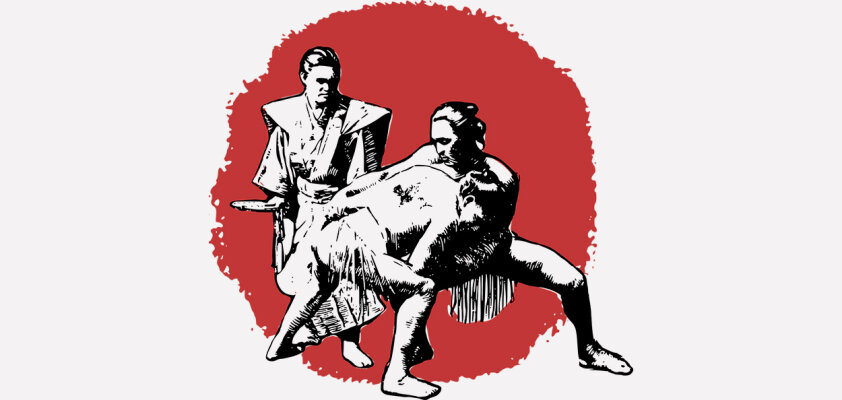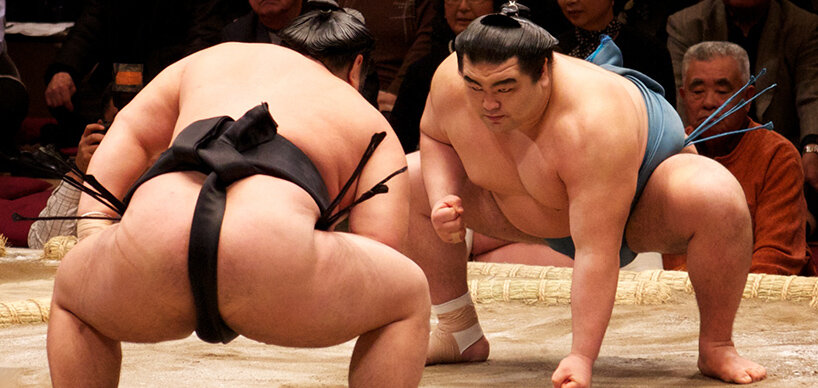Sumo Wrestlers, the Heaviest Athletes from Japan

Wrestling with stout Japanese individuals in aprons – that's how we envision Sumo. However, like all traditions in Japan, this one also has often unexpected historical and symbolic significance behind every detail, setting it apart from other sports. Sumo wrestlers face considerable challenges but play a crucial role in Japanese culture.
Japanese sport with spiritual roots
Sumo has been around for 1500 – 2000 years, but professional matches have only been held since the 17th century, during the Edo period. The Japanese sport originated from Shintoism, which, alongside Buddhism, is the primary religion in Japan. Initially, Sumo in Japan was part of a ritual to pray to the Shinto deities, Kami, for a bountiful harvest. Therefore, Sumo bouts were conducted in front of a shrine or temple before the first stadium was built in 1909. To this day, the ring (Dohyo) always has the roof of a Shinto shrine above it.
Even today, every Sumo wrestler, known as a Japanese Rikishi, who has attained the highest rank of Yokozuna, performs a kind of initiation ceremony in front of the Meiji Shrine in Tokyo. As a Yokozuna, one almost has the status of a deity in Sumo, but at the same time, there is immense pressure to maintain this status. Therefore, many Yokozuna end their careers early if they have lost too many matches to preserve their honor as grandmasters. In the history of Sumo, there have been only 70 wrestlers with this rank so far. In the ring, Yokozuna can be identified by the large rope around their waist, which includes paper decorations from Shintoism.

In addition to professional Sumo, distinguished by the term Ozumo, there are wrestlers who engage in the sport in their leisure time or as amateur Sumo, even worldwide.
Bowing, stamping and throwing salt - sumo wrestling rituals
In professional Sumo, the rituals and religious significance have remained largely unchanged to this day: Before a match can begin, numerous rituals must be performed. The famous stomping with both legs, known as Shiko, is believed to ward off evil spirits. The wrestlers bow to each other and sprinkle salt on the ring to purify it. The official bout only starts when both have placed their palms on the ring. Prior to this, you can observe a staring contest, a kind of psychological preparation called Shikiri, during which the sumo wrestlers squat multiple times and move around in the ring.
Each round usually lasts only a few seconds – until one of the wrestlers touches the ground or is thrown out of the ring. There are 70 different techniques for this purpose. Kicking, pulling hair, choking, or using a closed fist is prohibited. During this, the wrestlers often grab the opponent's belt (Mawashi) to apply their technique. It is very rare for a wrestler to lose their Mawashi, which results in disqualification.
However, this rule was introduced only after Sumo gained viewers worldwide who had more conservative views than fans in Japan.
Equally important is the role of the Gyoji – the referee in Sumo. The Gyoji wears a traditional kimono from the Samurai era, the black hat of a Shinto priest, and a sword, emphasizing the significance of their role. Like sumo wrestlers, Gyoji can hold different ranks, which can be identified by the color of their fan and their shoes. Judges, in black kimonos sitting around the ring, assist the Gyoji in controversial decisions.
How Sumo got fat
The rules for the Japanese sport were partly established at the imperial court when Sumo evolved into a court ceremony in the 8th century. However, during the Meiji Restoration in the 19th century, Sumo lost popularity, which was attempted to be restored in the post-war period with the help of the emperor and the media. This was successful, and since the 1990s, Sumo Wrestling has been broadcast globally.
Television broadcasts and videos on YouTube have shaped our perception of the hefty Sumo wrestler. On average, a Sumo wrestler weighs around 150 kilograms, with the heaviest fighter currently weighing over 300 kilograms.
However, Sumo wrestlers were not always this massive. The early fighters had more muscles than fat – even into the 20th century. In contrast to American wrestling, there are no weight classes in professional Sumo, so Sumo wrestlers can accumulate weight, even using fat, to have better chances in the ring. An example of a successful wrestler who relies on muscle weight is the Czech Takanoyama Shuntaro, nicknamed the "Skinny Sumo wrestler."

Picture Credits: Author: davidgsteadman | FlickrLicense
To achieve their ideal weight for the Japanese sport, Sumo wrestlers eat the traditional one-pot dish called Chanko Nabe for lunch after their training. It consists of a nutritious broth, noodles, fatty meat, seafood, and vegetables. A nap after the hearty meal supports weight gain. You can even try this calorie-rich dish in the Sumo district, Ryogoku Kokugikan, the spiritual home of Japanese sports in Tokyo and the location of the first and largest Sumo arena in Japan.
More than just a wrestler
The career of a Sumo wrestler lasts about 17 years, with most starting their training at around 15 years old. When they leave the ring, a Sumo wrestler doesn't shed their role. Even on the street, in both summer and winter, they must always wear their kimono, distinctive topknot, and use their stage name while remaining modest and reserved to maintain their public image. Many athletes are celebrated as media stars today, earning additional income through endorsements and television appearances. In retirement, most take on other jobs and may also join the Japan Sumo Association, the organization that manages Japanese Sumo and, among other things, the wrestlers' payments.
Every year in Japan, there are six major Sumo tournaments (Honbasho). Every two months, wrestlers compete for 15 days for coveted ranks in Sumo. Three of the tournaments take place at Tokyo's Ryogoku Kokugikan, and the others in Osaka, Nagoya, and Fukuoka. However, one must line up early as the coveted seats are allocated early in the morning, providing the opportunity to marvel at Sumo in the ring all day long.
From 9 a.m., the younger Sumo fighters compete, and the later the time, the higher the ranks: Rounds alternate until 6 p.m. Every Sumo wrestler fights once a day, each time against a different opponent. The one with the most wins relative to losses at the end of the tournament wins the Imperial Cup.
If you can't get a seat for a Sumo tournament, there are also numerous exhibition matches around Japan when Sumo wrestlers go on tour (Jungyo). Alternatively, you can visit one of the approximately forty stables in the Tokyo area where professional Sumo wrestlers train. Some of them allow visitors to experience a morning practice (Keiko).
Strict hierarchy in sumo
In these stables (Heya, literally: Room), approximately 15 Sumo wrestlers spend their daily lives together. This life is anything but easy: The master imposes strict rules on them, and experienced wrestlers have many privileges over the younger ones. They are cooked for and served by them, leaving only leftovers of their meals for the lower-ranking fighters. At 5 a.m., the younger wrestlers must be the first to prepare the ring for the morning training. After the sport and lunch, all residents of the stable have free time, while the starting wrestlers still have various household tasks to complete. If a young Sumo wrestler makes a mistake, they are punished – as a form of toughening up. Only when they marry are Sumo wrestlers allowed to move into their own apartments.
With a higher rank, one not only has a less strenuous daily life but usually only receives a regular salary when reaching the highest of the six divisions, Makuuchi,. Before that, a Sumo wrestler depends on their stable and any prizes from the Honbasho tournament. However, compared to other sports like wrestling, one earns relatively little money in Sumo – and runs the risk of being demoted if they have less luck in the ring.
Women are officially not allowed to participate in Japanese sports. They are not even allowed to enter the ring, as this is considered impure – a taboo maintained by the Japan Sumo Association. Although there were special Sumo matches for women during the Meiji era, they never became an official competition but rather served for entertainment.
Uncertain future for Japanese sport?
Unfortunately, fewer and fewer men aspire to become Sumo wrestlers today, as the training and life in the stable are very demanding and make it difficult to earn a living. Some Sumo wrestlers have even been involved in betting scandals with the Yakuza, the Japanese mafia, leading to a loss of fans.
For each training stable, only one wrestler born outside Japan is now accepted. Some of the most successful wrestlers come from Mongolia, South Korea, or Brazil. Financially, wrestlers from other countries have more motivation for the sport: In the past, a career as a Sumo wrestler was an opportunity for sons from poor village families to earn money, but such families are now scarce in Japan. With the shrinking population, there are also fewer Sumo wrestlers with Japanese roots, especially in the higher ranks.
On the other hand, small regional stables, especially for children, are becoming more common in Japan, particularly in Tokyo. There, even girls learn the sport in their free time, aiming to instill traditional values, physical and mental strength, and especially respect.

While many supporters of the sport in Japan call for modernization and openness, Sumo has, so far, remained true to the old rules and values as a tradition. All of this makes Japanese Sumo a rare cultural asset, which, despite all the challenges, has not lost its popularity to this day.
Summary
Sumo is an almost 2000-year-old tradition rooted in Shintoism, evident in its rituals and symbolic attire. The character and rules of the Japanese sport have gradually evolved since then. In Japan, there are six professional Honbasho tournaments each year, providing opportunities to experience Sumo, along with tours and amateur wrestlers. Sumo wrestlers start training around the age of 15 in specialized stables, leading a challenging lifestyle, and typically engage in the sport until their 30s. Six divisions categorize the numerous ranks in Ozumo, the professional Sumo, with Yokozuna being the highest and rarest rank. The excess fat primarily serves to increase the weight of Sumo wrestlers, although muscles can also contribute to success in the ring. Ozumo is reserved for men and limits the sport for foreigners; however, an increasing number of wrestlers from outside Japan are achieving higher ranks. Successful Sumo wrestlers enjoy media attention and a broad fan base but must preserve their role and, with great effort and endurance, maintain their position in the unforgiving ranking system.











-from-the-yakiyaki-grill-pan.jpg)




